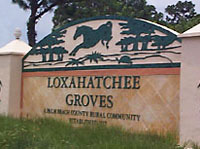The first joint meeting of the Loxahatchee Groves Roadways, Equestrian, Trails & Greenway Advisory Committee (RETGAC) and the Financial Accounting & Audit Committee (FAAC) was held Wednesday, Dec. 4 to develop realistic goals for the future of the town.
Three committee members from each committee were present — RETGAC members Paul Coleman, Jodie Jansen and Dr. Bill Louda, and FAAC members Anita Kane, Laura Cacioppo and Bruce Cuningham. FAAC Chair Kane was nominated chair of the joint committee, while RETGAC Chair Louda was nominated as vice chair.
The joint committee first approved a proposed mission statement: To recommend capital improvements (including renewal and replacement), project priorities and potential funding mechanisms for consideration by the Loxahatchee Groves Town Council in their budget and capital improvements preparation, which carried 6-0.
“The second thing we have is copies of the extensive work the RETGAC committee had already done on road classifications,” Kane said. “The third thing we have is cost-sharing policies that already have been adopted in the past and have been or may be implemented.”
The committee members also discussed a lengthy list of possible projects to be considered, as well as a list of current fund balances that will be used to implement future projects, along with a bulky volume of local and state laws enumerating how and when funds can be spent.
“It’s not just a matter of do we have the money, it’s that some money is restricted for this, some is for that, so this has to be married with that before we can make decisions about how to spend these monies,” Kane said, adding that she had reached out to council members asking them to supply a list of their personal priorities. “I thought that was fairly important before we spend a great deal of time doing this work to at least see what page they were on.”
The committee then discussed a local road classification system approved by RETGAC with five service levels: roads with access to both Okeechobee and Southern boulevards, roads that have access to either Southern or Okeechobee, east-west connectors with public access between service level 1 roads, non-through public access roads and non-through private roads. The first four classifications would qualify for funding from gas taxes, road and drainage or cost sharing assessments. For private roads, the owner(s) would be solely responsible for improvements and maintenance at town standards.
Planning Consultant Jim Fleischmann said the service levels had been developed by the town.
“We had two objectives in mind in doing this,” Fleischmann said. “We recently received a grant from the state to update our capital improvements element and our transportation and land use element in the comprehensive plan. In the comprehensive plan currently, our road classification map only has two roads on it. Okeechobee is an urban collector, and Southern Blvd. is a principal arterial. We decided that we needed to be more specific and also come up with a classification system for the local roads that we included in the comprehensive plan and would also be helpful in future capital improvement decisions.”
He explained that text had been included that would be proposed for future comprehensive plan amendments.
Cacioppo noted that there has been more cut-through traffic on Citrus and Tangerine drives since construction began on Southern Blvd. and felt some additional funding should be made available short-term until Southern is finished. “Whatever roads are getting more traffic,” she said. “It could be all the way up to Collecting Canal or Sixth Court North, getting a lot more traffic because people are cutting through all day at very high rates of speed.”
Coleman said his committee had discussed increased traffic and a possible need for additional maintenance on Tangerine.
“I hear what you’re saying,” Coleman said, pointing out that increased accidents on Southern are leading to more cut-through traffic. “We did discuss Tangerine and Citrus in depth at one of the meetings, and the feel is that it has high traffic on it right now, so there needs to be a priority for maintenance on that road.”
Kane suggested that funding might be available from the state while the traffic is being diverted. She also noted that some roads in town have become so deteriorated that local traffic is using other routes.
“I know that when North F Road deteriorates like it is right now, and you can’t drive on it, I don’t use it anymore,” she said. “I come down Folsom. I know that at least five of my neighbors come all the way down Folsom because driving F Road is impossible.”
The joint committee also discussed RETGAC’s ranking of various projects, with repair and restoration of all canals ranking first for renewal and replacement projects. OGEM repairs for A and F roads ranked second, road base and sodding ranked third, and culvert repairs were fourth.
For capital projects, surface water management and flood control was first; equestrian and multi-use trails for all letter roads, Okeechobee Blvd., the east side of Folsom and Sixth Court North were second; Okeechobee Blvd. signalization and/or roundabouts was third; a catch basin project was fourth; and grid road paving was fifth.
Kane asked why 40th Street North had not been included among equestrian trail capital projects. Fleischmann said RETGAC members were given the option of including specific locations on their ranking sheet, and 40th Street North had not come up.
“Can I ask then that you guys in a new iteration consider at least adding 40th?” Kane asked.
After more discussion, Coleman made a motion to approve the items that had been discussed for submission to the council, which carried 6-0.
Kane said the joint committee’s next assignment would be to review council members’ comments and come back to its next meeting with suggestions of how they should be funded.
Coleman suggested getting a report from the town engineer on his priorities. “It would be helpful,” he said.








